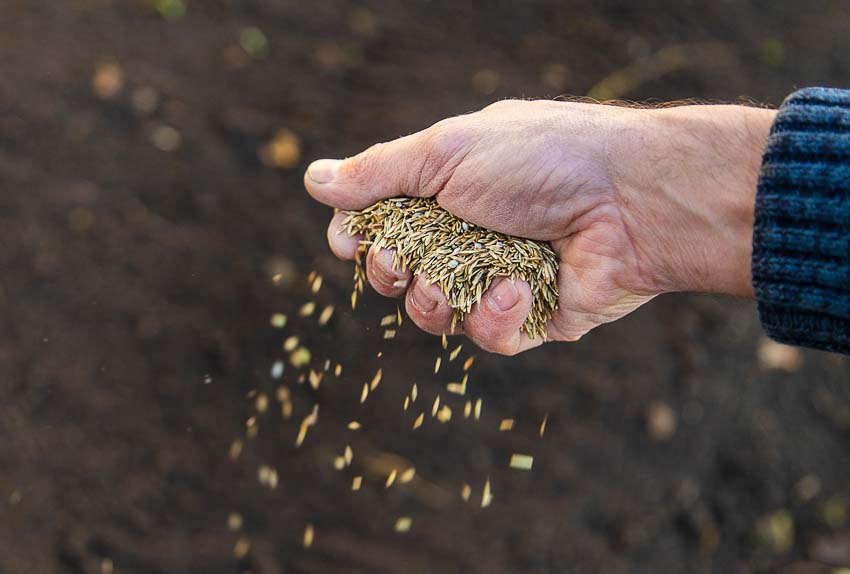If you missed the ideal time to plant your lawn, it’s not too late. Seeding grass in winter is a viable option for many climates. Discover the best techniques and grass varieties to successfully seed your lawn in the winter with these lawn care and maintenance tips.
When to Seed Grass in Winter
You can seed grass in the winter when soil temperatures are cold, but the ground isn’t frozen. That way, the grass will germinate when the soil temperatures warm up in the spring, and you’ll have a lush green lawn ready to start a new growing season.
Spring vs. Fall Seeding
The best times to plant grass seed are spring and fall. Spring rains and warm soil temperatures create the perfect environment for germinating grass seeds.
In southern climates, warm-season grasses are in peak growth cycles during late spring and early summer. Spring is the best time to plant grass seed, when soil temperatures reach 65-70°F (18-21°C).
In northern climates, the best time to plant cool-season grass is when the temperatures are consistently 50-60°F (10-15°C). You can also plant cool-season grass in the spring.
However, if you miss these ideal planting dates, you can use a technique called dormant grass seeding, where you plant grass seed during the winter.
Ideal Winter Seeding Times
The best time to plant grass seed in the winter is when the soil temperatures are about 40°F (4°C). You want to ensure that it doesn’t germinate, and then experience a setback due to a cold snap. So, in many places, the best time for winter seeding is in December and January. This is when temperatures are least likely to warm up enough to sprout your grass seed.
Choosing the Right Grass Seed Varieties
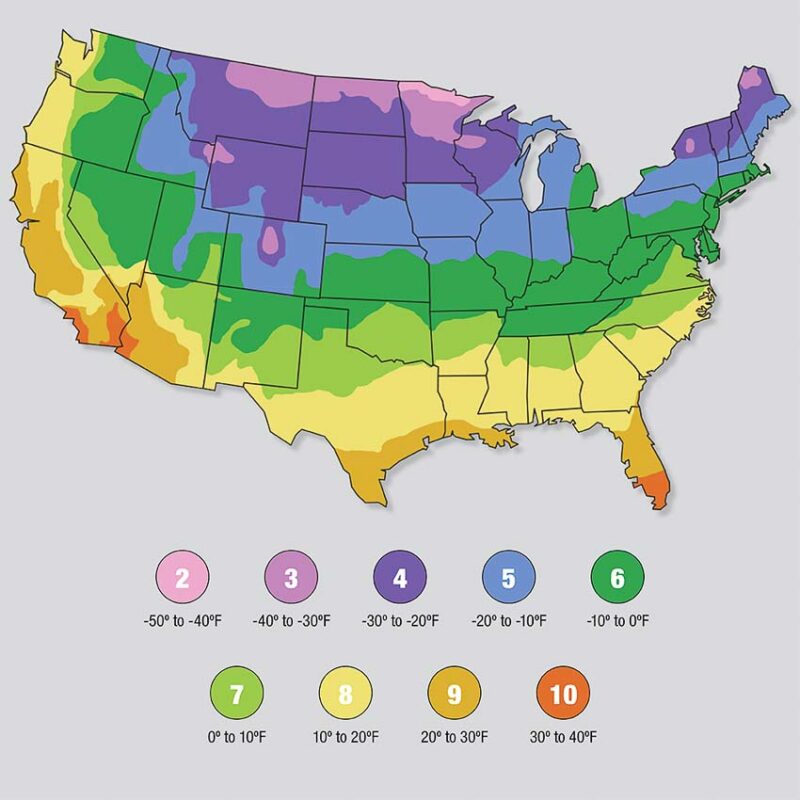
When winter seeding grass, whether planting a new lawn or overseeding your existing lawn to fill in bare spots and patchy areas, choose the right grass seed varieties for your climate and region.
Cool Season Grasses
Cool-season grasses, like Kentucky bluegrass, Perennial Rye, and fescues, grow best in cooler climates. They like cool, moist soil and don’t tolerate drought and extremely hot weather.
Warm Season Grasses
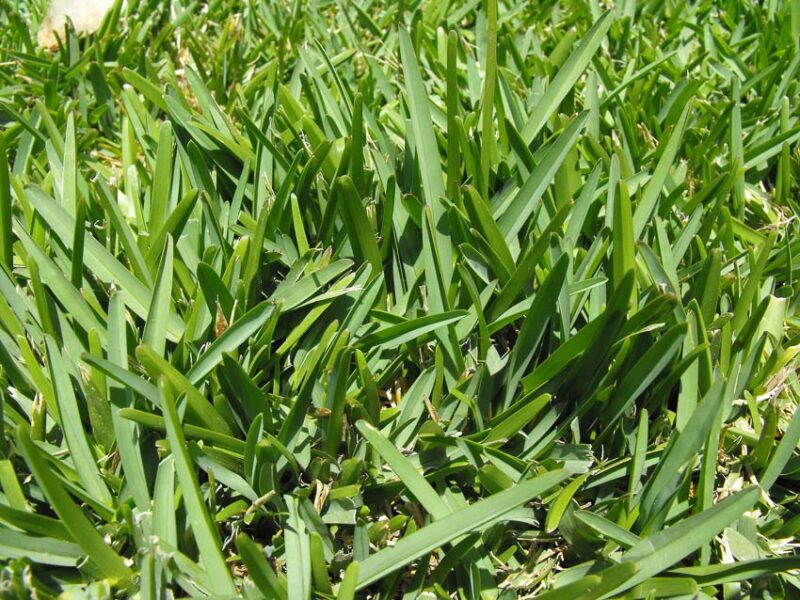
In southern climates, where drought conditions and extreme heat can be tough on your lawn, warm-season grasses are the best choice.
Grass varieties like Bermuda grass, zoysia grass, and St. Augustine grass are semi-tropical species that like a lot of heat. Hence, they can withstand the hot temperatures in the middle of summer better than cool-season grasses.
Purchasing High-Quality Seed
High-quality grass seed makes a difference in your lawn. Grass seed can be expensive. However, when you start with quality, you’ll have better germination rates, fewer weed seeds, and better resistance to diseases and pests.
Choosing a locally grown grass seed from a reputable grass grower in your region is the best option. You can be sure you’ll get a blend of grass seeds that will perform well in your climate.
Lawn Preparation for Winter Seeding
Preparing the ground for winter grass seeding is similar to preparing it for spring or fall plantings. Remove debris, loosen the soil, and add some fertilizers. Then, plant grass seed at the optimal time for the best results.
Remove Debris
To oversee your lawn in the winter using a dormant seeding method, you need to prepare the ground by removing debris. Rake up all leaves, sticks, and rocks so that the surface of your lawn is even. This will help the seed make good contact with the soil.
If you’re planting a new lawn in the winter, it’s best to prepare the area before the ground freezes. Remove debris by picking up large debris and raking the area.
Loosen Soil
If your ground isn’t quite frozen, you can use various methods to loosen the soil before planting. This will ensure good seed-to-soil contact for the best germination rates.
Aerate your lawn
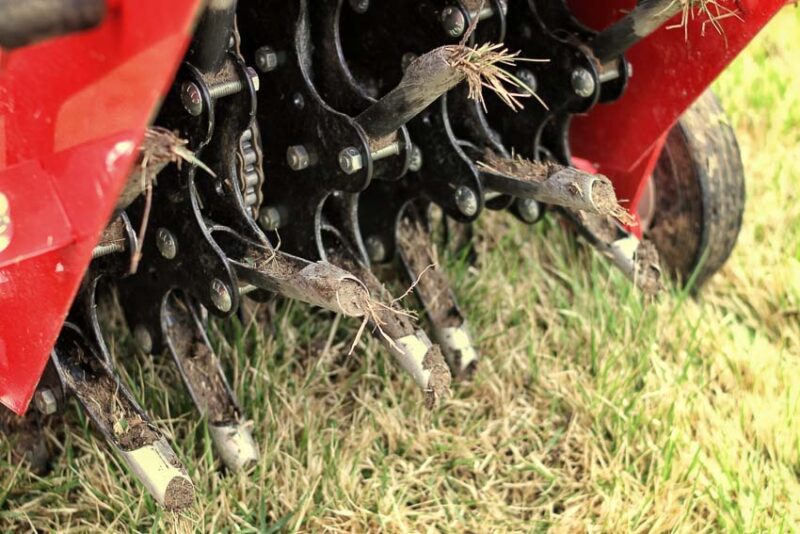
Mid to late October is a good time to aerate your lawn, as it’s already going dormant. Air and soil temperatures have cooled down, but most regions don’t have frozen ground. Aerating is suitable for an existing lawn and will also help promote seed-to-soil contact for dormant seeding.
Dethatch your lawn
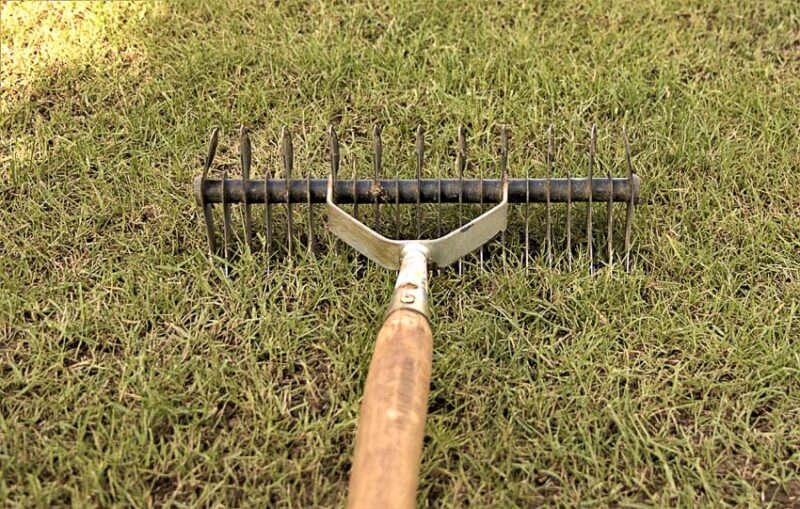
For cool-season regions, you can dethatch your lawn as late as early October, which will help loosen the soil for dormant seeding in the winter.
You should dethatch your lawn every three to five years. You can use a dethatching rake for this job if you have a small to medium-sized lawn.
Rake
You can use a hard rake to loosen the soil so that it makes good contact with your grass seed. Go over your lawn a few times in different directions.
Till
If you’re planting a new lawn, you can till the soil and prepare it as you would for planting any time of year. Use a shovel or rototiller to till it to a depth of about 6 inches, then rake it smooth.
Fertilize
As soon as your grass germinates and starts to wake up in the spring, it needs nutrients. Fertilizing your lawn soil before you plant means it will be readily available to your new grass seedlings.
Seeding Methods and Techniques
Once you’ve prepared the lawn area, use one of the following seeding techniques.
For dormant seeding, soil temperatures should be consistently 40°F (4°C) or lower. If you plant too early, the seed may germinate prematurely, and a hard freeze can zap the tiny seedlings. Sometimes, it’s best to wait until the ground is slightly frozen.
Broadcast Spreading
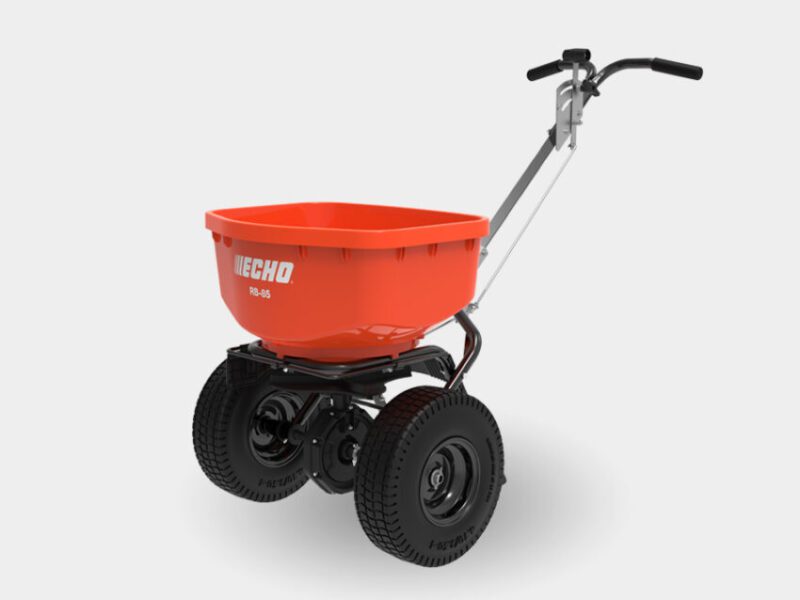
Broadcast spreaders are favorites among yard enthusiasts. As their name suggests, they broadcast seed during application, covering a wide area. It usually overlaps swaths to ensure even application.
Choose between handheld, push, and tow-behind broadcast spreaders, depending on the size of your lawn. Investing in one makes sense because you can use it to apply granular herbicides and fertilizers.
Drop Seeding
Drop seeders are another type of spreader that you can use to seed grass in winter. The two main types of drop spreaders are push and tow-behind models. Instead of broadcasting a wide swath of seeds, drop spreaders deliver them directly below the spreader, making them more accurate than broadcast spreaders.
Hydroseeding
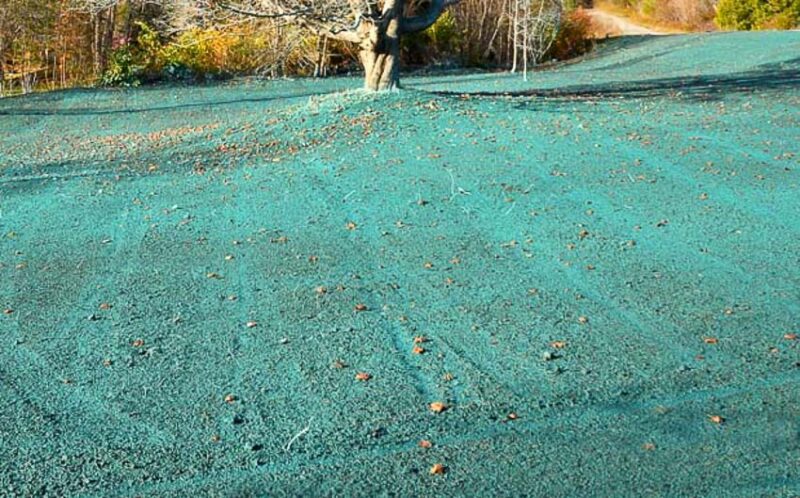
Hydroseeding is a planting method where you mix together grass seed, water, fertilizer, and mulch, then spray them on the ground. It’s an effective method for planting grass, usually resulting in better germination rates and less seed movement.
You can rent a hydroseeder and DIY it, but most people hire a professional hydroseeder.
Erosion Control
Dormant seeding is more prone to problems with erosion because there are more agents of change from winter to spring. Snow melt and heavy spring rains can wash away the grass seed unless you keep it in place.
Hydroseeding will help counteract the effects of erosion. You can also use straw mulch or erosion-control blankets.
Caring for Seeded Lawn
Newly seeded lawns require extra attention and nurturing. Because their root systems haven’t yet established, they need frequent watering. You also need to protect grass seedlings from human activity and foot traffic.
Watering Requirements
How often should you water a dormant-seeded lawn? You don’t need to do anything until it comes up in the spring, but once the tiny grass seedlings start to sprout, the top layer of soil needs to stay moist for about three weeks.
When the grass is an inch tall, you can cut back slightly on watering. But, pay close attention to its watering needs until the lawn is completely established.
Protecting Seedlings
Grass seedlings are vulnerable to foot traffic, whether from pets or humans. So, you may need to cordon off the parts of your lawn where you’ve planted grass seed.
About a month after it comes up, your grass should be long enough to mow. However, it may need a few more weeks before you can walk on it. Once it’s several months old, you can treat it as an established lawn.
Overseeding vs Seeding Grass in Winter
You can use dormant grass seeding to overseed your existing lawn or plant a new one. In both cases, the process is similar and requires the same care while it establishes.
Overseeding Existing Lawns
Most people don’t think of winter when they think of overseeding their lawn, but it’s actually the perfect time to do it. For one, you aren’t actively mowing or using your lawn for recreation during the winter.
Another reason winter is a good time to overseed is that you don’t have to worry about getting rid of weeds, and the freezing and thawing of the ground can help promote good seed-to-soil contact.
Winter overseeding, also known as frost seeding, is also helped by a layer of snow on top of your lawn, which keeps the seed in place throughout the winter. Then, the melted snow will help the seeds germinate once the temperatures warm up.
Seeding a Lawn from Scratch
When planting a new lawn from scratch, dormant seeding can be done anytime after mid to late November, when the soil temperatures are too cool for seeds to germinate. All the advantages of overseeding during the winter apply to seeding a lawn from scratch.
Winter Seeding Challenges and Solutions
Sometimes, winter seeding doesn’t go according to plan, however. There are challenges to watch out for, but there are solutions to ensure that dormant seeding your lawn is successful.
Germination Issues
You may have issues with germination when you’re winter seeding your lawn. If your grass seeds sprout during a warm period and the weather turns cold, the frost can push them out of the ground and freeze them.
A light layer of straw mulch will protect the grass from this issue.
Washout and Erosion
Excessive snowmelt in the spring can cause excessive erosion, especially in sloped yards. This doesn’t happen every year, but sometimes, it’s enough to destroy your dormant seeding efforts.
To combat this issue, use erosion control blankets or hire a professional to hydroseed your lawn.
Wildlife Grazing
Winter is a time of scarcity for many species of wildlife. Whether it’s mice or birds, hungry critters can eat enough of your newly planted grass seed to put your new lawn at risk.
Try covering the grass seed with burlap or bird netting. If the birds persist, you can make a homemade bird repellent with natural products like peppermint oil or garlic and cayenne pepper spray to deter them.
FAQs About Seeding Grass in Winter
What type of grass seed is best for winter planting?
The best type of grass seeds for winter planting are cool-season grasses like perennial ryegrass, Kentucky bluegrass, or fescues.
When is the cut-off date for winter seeding?
The cut-off date for planting grass in winter depends on your climate. The best time to sow grass seed in the winter is mid-November to December, but in many growing z ones , you can dormant plant grass seed until the end of February.
Some studies suggest that February is the best time to plant grass seed in the winter.
How do I care for newly seeded grass in winter?
The goal when you plant grass seed in the winter is to have the seeds germinate as early in the spring as possible. After planting grass seed in the winter, you don’t need to do anything until it starts to germinate when soil temperatures warm up in the spring, usually in mid to late March.
What causes seeded grass to die in winter?
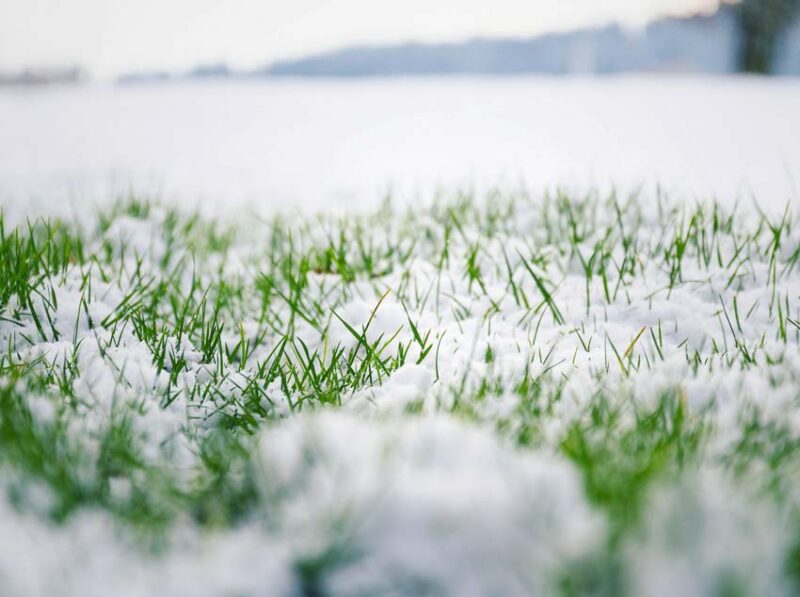
Winter grass seeding is usually effective because the seed will remain dormant until the soil temperatures warm up in the spring. However, if there is a warm spell, your grass can germinate and then die during a subsequent cold snap.
Is hydroseeding effective for winter lawns?
Hydroseeding is an effective way to plant grass seed and works well for planting winter lawns. The goal is to take advantage of snow melt and early spring rains and have the seed germinate as soon as possible in the spring.

